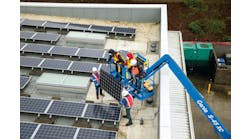Driven by robust growth in emerging markets and strength in key industries like energy and mining, Caterpillar Inc. last week reported all-time records for sales and revenues and profit per share for the second quarter of 2008.
Profit per share was $1.74, a 40-percent increase from $1.24 per share in the second quarter of 2007. Sales and revenues of $13.6 billion were 20-percent higher than second-quarter 2007 sales and revenues of $11.4 billion.
“While North America remains depressed and we’ve seen softening in Western Europe and Japan, Caterpillar continues to grow in emerging markets and in global industries like energy and mining … and we continue to see good growth in our integrated service businesses,” said chairman and CEO Jim Owens. “It’s gratifying to see the positive impact of being such a diverse company in terms of products, services, geography and the industries we serve.”
Sales and revenues were up $2.3 billion from the second quarter of 2007. Sales volumeimproved $1.4 billion, price realizationwas up $398 million, the impact of currencyadded $384 million and financial products revenues were $84 million higher. The geographic mix of sales continued to shift outside North America with sales and revenues increasing 30 percent outside North America compared with 7 percent inside North America.
Sales volume increased in North America largely because dealers did not reduce their inventories as much as a year earlier, the company said. Dealer inventories at the end of the quarter were higher than a year earlier in both dollars and months of supply.
U.S. housing faced the worst environment since the 1930s. Starts fell 30 percent from a year earlier, new home sales plunged more than 40 percent and homebuilders held almost an 11-month supply of unsold homes. Home repossessions soared, and the decline in home prices appeared to worsen.
In addition, employment in the nonresidential construction sector declined more than 4 percent from second quarter 2007. Banks tightened lending standards for commercial and industrial loans, property prices softened and vacancy rates increased.
Sales and revenues outside North America represented 60 percent of total sales and revenues in the second quarter — up from 55 percent of the total a year ago. Second-quarter profit of $1.1 billion was up $283 million, or 34 percent, from second-quarter 2007 profit of $823 million. The increase was primarily a result of improved price realization and higher sales volume, partially offset by higher material and freight costs and increases in selling, general and administrative and research and development expenses.
Sales volume in Europe, Africa/Middle East increased due to strong growth in Africa/Middle East and the Commonwealth of Independent States. The European economy slowed in the second quarter, with consumer spending and housing most affected. Year-to-date, euro-zone housing permits declined 20 percent, and housing orders in the United Kingdom dropped 26 percent. Reports indicate home prices are declining in the United Kingdom, Ireland and Germany. Nonresidential construction also started to decline in the second quarter.
Sales volume increased significantly in Africa/Middle East, particularly in the oil-producing countries. The 80-percent rise in the Organization of the Petroleum Exporting Countries crude oil reference price caused countries to increase production 6 percent and increase operating drill rigs 7 percent. Increased oil revenues and expansive economic policies sustained construction booms.
The CIS was the biggest contributor to the growth in sales volume. Large gains occurred in Russia, Ukraine and Kazakhstan. Low interest rates, rapid money growth and increased government spending caused rapid growth in construction. Mining and oil production also increased in response to higher prices.
Sales volume increased substantially in China, the result of the addition of locally produced wheel loaders and expansive economic policies. Housing construction increased 35 percent, and nonresidential construction was up 14 percent. Mine output increased, with coal up 16 percent and iron ore up 25 percent.
Economic policies in India, despite some tightening, remain very expansive, Caterpillar said. Construction increased almost 13 percent, industrial production increased 5 percent and mining was up 6 percent. As a result, sales increased rapidly.
The full-year outlook for 2008 reflects sales and revenues of about $50 billion and profit of about $6.00 per share. The previous outlook expected 2008 sales and revenues of $47.2 to $49.5 billion and profit per share of $5.64 to $6.18.
“Never in my 35-plus years with the company have I seen Caterpillar do so well in the face of such a difficult economic climate in the United States,” Owens said. “We are on track to deliver our fifth straight year of record profits despite very tough conditions in the United States, declines in Europe and significantly higher material costs, particularly in the second half of the year. Still, for many of our products, supply is very tight, and we are producing as much as we can. That’s why in June we announced capacity expansions in the United States, China and India. We need to bring additional capacity on line to support world demand for infrastructure, energy and mining, and to be prepared for the upturn in the United States when it comes. Together with the best dealer network in our industry, Team Caterpillar is well positioned to meet our goals for 2010 and beyond.”
Peoria, Ill.-based Caterpillar manufactures construction and mining equipment, diesel and natural gas engines and industrial gas turbines. The company also is a leading services provider through
Caterpillar Financial Services, Caterpillar Remanufacturing Services, Caterpillar Logistics Services and Progress Rail Services.





